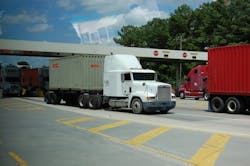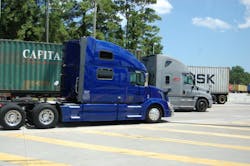So, while leafing through the latest “yearbook of trucking” compiled annually by the American Trucking Associations (ATA), a certain thought occurred to me: what if the industry starts to shrink in size?
What if, because no one wants to be a truck driver anymore, fewer and fewer trucks are available to haul things? How will that affect the U.S. economy? More importantly, how will that impact daily life; a life built around cheap and often next-day delivery of just about everything?
According to ATA’s data, motor carriers collected $726.4 billion in gross freight revenues and hauled 10.49 billion tons of freight in 2015; 81.5% of the nation’s freight bill and 70.1% of domestic freight tonnage, respectively. To get all of that done, the data says, the industry operated some 3.63 million trucks.
OK: so let’s say in two years we need to idle 200,000 of those trucks due to a dearth of drivers. Or maybe 500,000 of them – maybe even a million. What happens next? How many billion tons less can we suffice to part with?
I mean, does overnight delivery go away? Do we go back to the good old days of “please allow for five to six weeks for delivery” written in big, bold leaders in every catalog I perused some 20-odd years ago? Does the “free and fast” shipping e-commerce environment disappear?
What about food shipments? The grocery stores where I live are reloaded once and even twice a day out of the backs of 18-wheelers with fresh produce flown in from all-four corners of world, along with all sorts of home-grown items transported by rail and truck from our nation’s breadbasket in the Midwest. What happens to all of that? Do foodstuffs get rationed? Do we adopt a Soviet-style type of market, with just potatoes and bread on the shelf every day, while meat only gets delivered on Tuesdays?
Sure I exaggerate more than a bit here. But let’s call this exercise an application of the “tenth man” theory:
John Larkin, managing director & head of transportation capital markets research for Stifel Financial, recently illustrated several key points underpinning why I think the trucking industry may be poised for significant shrinkage.
While he certainly didn’t make any predictions along those lines during a sit-down interview with The Wall Street Transcript back in June, his comments on the state of trucking surely give one pause.
For starters, look at the broad economic picture for the U.S.; one that paints a “slow and sluggish” environment:
- The underlying economy since the beginning of the recovery back in 2008 and 2009 has been pretty slow, averaging around 2% per annum. We’ve had a problem this year coping with a stronger dollar, which has really put a damper on what was a very favorable export trend, with that strong dollar “lighting a fire,” in his words, under the import market.
- Importing more and exporting less is typically not a good thing for transportation companies as exports are touched multiple times by transport companies prior to being exported, whereas imports are generally just touched once or twice. [Though that changes when re-shoring is added to the mix.]
- Furthermore, the savings consumers have been accruing at the fuel pump due to low oil prices have not really been spent on retail goods the way many analysts thought would be the case.
- So at the end of the day, the economy is sort of limping along at a sub-potential rate of growth. And with the existence of some bloated inventories in the first half of 2015, transportation volumes have been noticeably sluggish across the board.
Now look at trucking and how difficult it is becoming just maintain current capacity levels, which, frankly, most motor carriers would rather not maintain because of the aforementioned “sluggish” freight demand:
- Larkin believes the labor shortage in trucking “will continue to be fairly severe” and will just get more severe with the implementation of new regulations, such as the one mandating electronic logging devices (ELDs) for all commercial vehicles.
- One of the “misconceptions” out there in the market is that people think that simply raising pay is the solution to the truck driver problem.
- He argued that if pay was the answer, “then the highest paying carriers should have a line out the door of drivers waiting to sign up.”
- Yet while there remains quite a “differential” between the highest-paying carriers and the lowest-paying carriers – “let’s say maybe $100,000 a year on the high-end and $40,000 on the low end,” in Larkin’s words – trucking companies large and small today are all struggling to seat their trucks with compliant drivers across that entire pay spectrum.
“They [motor carriers] have really gone over the top here to try and make truck driving a more attractive job,” he explained. “Yet just about all carriers are still struggling to seat their equipment with qualified, compliant drivers.”
Here’s the thing, though: Larkin stressed that the problem is there is not enough rail capacity, nor air capacity, to handle all the trucking volume that will result from an inability to find drivers.
“The trucking industry has much more volume than all of the other modes combined, which is another generally unknown fact,” he emphasized. “So we really can’t do without trucking, especially in the shorter-haul, lighter-density markets where neither intermodal nor any other form of rail nor air makes any sense. So trucking is going to be with us for the foreseeable future.”
Trucking will remain, for sure, but will it stay big enough to handle all the demands the U.S. economy is placing upon it? That’s only one of the many questions regarding trucking’s future that will need answering sooner rather than later.


